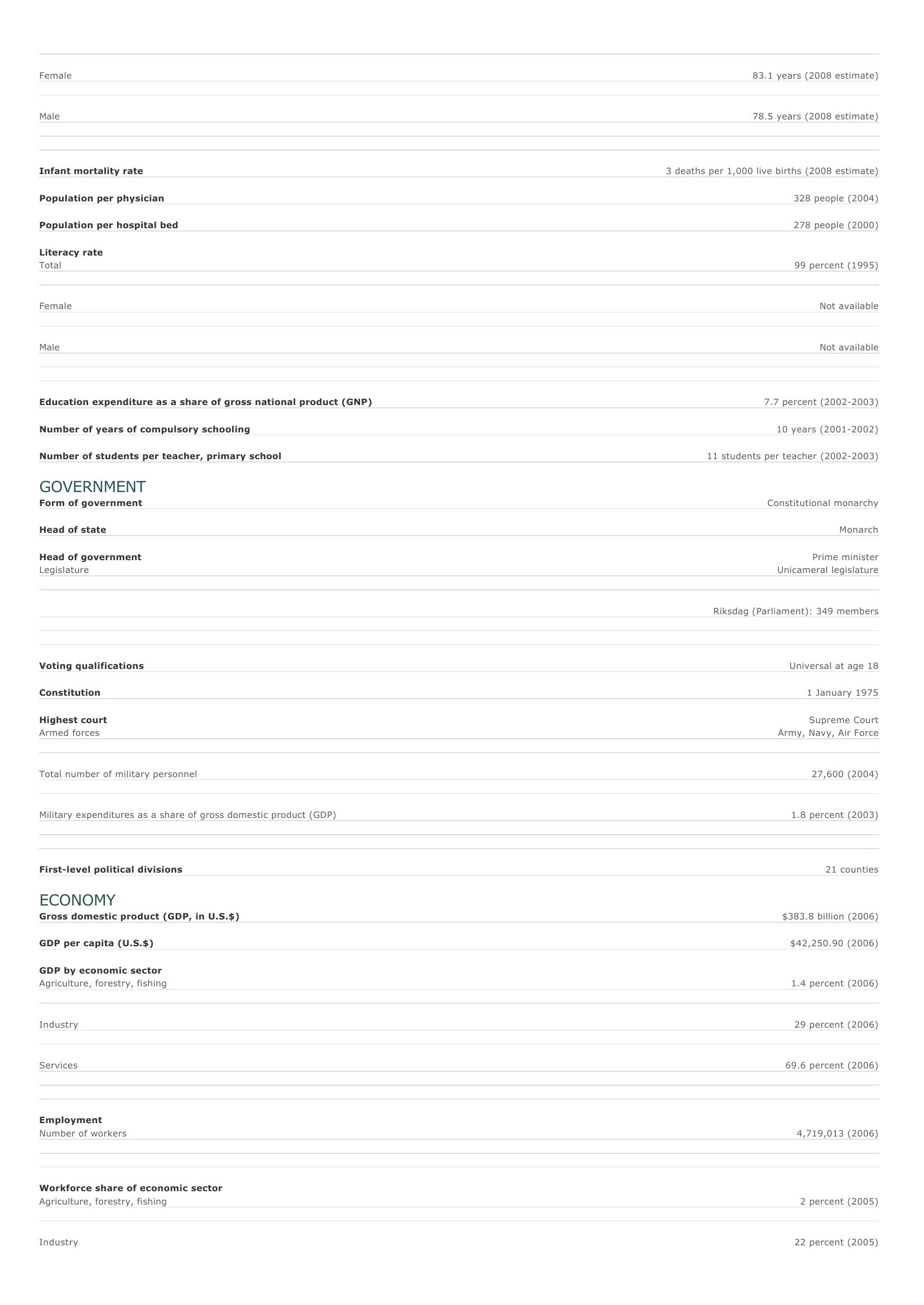Sweden Facts and Figures. BASIC FACTS Official name Capital Area Kingdom of Sweden Stockholm 449,964 sq km 173,732 sq mi PEOPLE Population 9,045,389 (2008 estimate) Population growth Population growth rate 0.16 percent (2008 estimate) Projected population in 2025 9,315,507 (2025 estimate) Projected population in 2050 9,084,788 (2050 estimate) Population density 22 persons per sq km (2008 estimate) 57 persons per sq mi (2008 estimate) Urban/rural distribution Share urban 83 percent (2005 estimate) Share rural 17 percent (2005 estimate) Largest cities, with population Stockholm 761,721 (2004 estimate) Göteborg 478,055 (2004 estimate) Malmö 267,171 (2004 estimate) Uppsala 180,669 (2004 estimate) Linköping 136,231 (2004 estimate) Ethnic groups Swedish, Saami, Finnish, Yugoslav, Danish, Norwegian, Greek, Turkish Languages Swedish (official), English, small Saami- and Finnish-speaking minorities Religious affiliations Protestant (Evangelical Lutheran) 68 percent Roman Catholic 2 percent Muslim 2 percent Orthodox Christian 1 percent Nonreligious O ther 18 percent 9 percent HEALTH AND EDUCATION Life expectancy Total 80.7 years (2008 estimate) Female 83.1 years (2008 estimate) Male 78.5 years (2008 estimate) Infant mortality rate 3 deaths per 1,000 live births (2008 estimate) Population per physician 328 people (2004) Population per hospital bed 278 people (2000) Literacy rate Total 99 percent (1995) Female Not available Male Not available Education expenditure as a share of gross national product (GNP) Number of years of compulsory schooling Number of students per teacher, primary school 7.7 percent (2002-2003) 10 years (2001-2002) 11 students per teacher (2002-2003) GOVERNMENT Form of government Head of state Head of government Legislature Constitutional monarchy Monarch Prime minister Unicameral legislature Riksdag (Parliament): 349 members Voting qualifications Constitution Highest court Armed forces Total number of military personnel Military expenditures as a share of gross domestic product (GDP) First-level political divisions Universal at age 18 1 January 1975 Supreme Court Army, Navy, Air Force 27,600 (2004) 1.8 percent (2003) 21 counties ECONOMY Gross domestic product (GDP, in U.S.$) $383.8 billion (2006) GDP per capita (U.S.$) $42,250.90 (2006) GDP by economic sector Agriculture, forestry, fishing 1.4 percent (2006) I ndustry 29 percent (2006) Services 69.6 percent (2006) Employment Number of workers Workforce share of economic sector Agriculture, forestry, fishing I ndustry 4,719,013 (2006) 2 percent (2005) 22 percent (2005) Services Unemployment rate 76 percent (2005) 6.5 percent (2004) National budget (U.S.$) Total revenue $145,537 million (2006) Total expenditure $136,026 million (2006) Monetary unit 1 Swedish krona (SKr), consisting of 100 öre Agriculture Dairy products, meat, cereals, potatoes Mining Iron ore, uranium, lead, silver, copper, zinc, gold, petroleum, iron pyrites Manufacturing Transportation equipment, food products, paper, machinery, metal products, wood products, chemicals, electrical goods, printed and published material Major exports Transportation equipment, paper and paper manufactures, chemicals, raw and processed forest products, electronic sound equipment, iron and steel, power-generating equipment, ships Major imports Chemicals, petroleum and petroleum products, transportation equipment, food products, computers and office machines, clothing and accessories Major trade partners for exports Germany, United States, United Kingdom, Norway, Denmark, and Finland Major trade partners for imports Germany, Norway, United Kingdom, Denmark, and Netherlands ENERGY, COMMUNICATIONS, AND TRANSPORTATION Electricity production Electricity from thermal sources Electricity from hydroelectric sources Electricity from nuclear sources Electricity from geothermal, solar, and wind sources 6.80 percent (2003 estimate) 41 percent (2003 estimate) 48.59 percent (2003 estimate) 3.61 percent (2003 estimate) Number of radios per 1,000 people 932 (1997) Number of telephones per 1,000 people 717 (2004) Number of televisions per 1,000 people 571 (2000 estimate) Number of Internet hosts per 10,000 people 1,051 (2003) Daily newspaper circulation per 1,000 people 410 (2000) Number of motor vehicles per 1,000 people 504 (2003) Paved road as a share of total roads 31 percent (2003) SOURCES Basic Facts and People sections Area data are from the statistical bureaus of individual countries. Population, population growth rate, and population projections are from the United States Census Bureau, International Programs Center, International Data Base (IDB) (www.census.gov). Urban and rural population data are from the Food and Agriculture Organization (FAO) of the United Nations (UN), FAOSTAT database (www.fao.org). Largest cities population data and political divisions data are from the statistical bureaus of individual countries. Ethnic divisions and religion data are largely from the latest Central Intelligence Agency (CIA) World Factbook and from various country censuses and reports. Language data are largely from the Ethnologue, Languages of the World, Summer Institute of Linguistics International (www.sil.org). Health and Education section Life expectancy and infant mortality data are from the United States Census Bureau, International Programs Center, International database (IDB) (www.census.gov). Population per physician and population per hospital bed data are from the World Health Organization (WHO) (www.who.int). Education data are from the United Nations Educational, Scientific and Cultural Organization (UNESCO) database (www.unesco.org). Government section Government, independence, legislature, constitution, highest court, and voting qualifications data are largely from various government Web sites, the latest Europa World Yearbook, and the latest Central Intelligence Agency (CIA) World Factbook. The armed forces data is from Military Balance. Economy section Gross domestic product (GDP), GDP per capita, GDP by economic sectors, employment, and national budget data are from the World Bank database (www.worldbank.org). Monetary unit, agriculture, mining, manufacturing, exports, imports, and major trade partner information is from the statistical bureaus of individual countries, latest Europa World Yearbook, and various United Nations and International Monetary Fund (IMF) publications. Energy, Communication, and Transportation section Electricity information is from the Energy Information Administration (EIA) database (www.eia.doe.gov). Radio, telephone, television, and newspaper information is from the United Nations Educational, Scientific and Cultural Organization (UNESCO) database (www.unesco.org). Internet hosts, motor vehicles, and road data are from the World Bank database (www.worldbank.org). Note Figures may not total 100 percent due to rounding. Microsoft ® Encarta ® 2009. © 1993-2008 Microsoft Corporation. All rights reserved.






